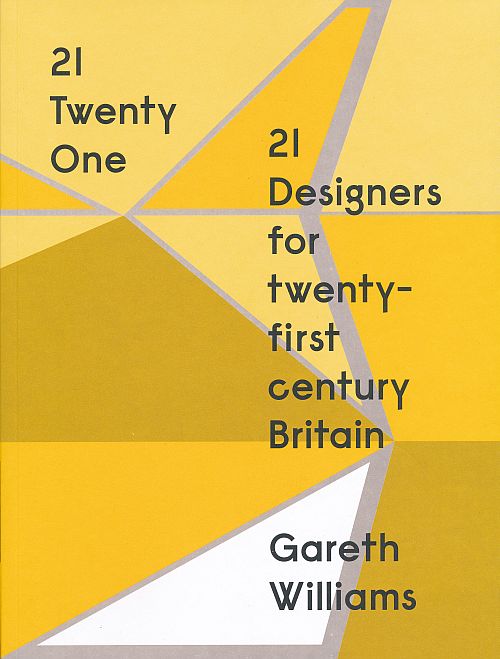
The V&A Museum London exhibition "British Design 1948-2012" pretty much does what it says on the tin. It reviews British Design from 1948 to 2012.
But how does the future look ? Where is British design going ? What issues are important? Where do the coming generation of designers see their futures ?
Answers to these and similar questions can be found in the newly published "21 Designers for twenty-first century Britain" by Gareth Williams.
Profiling designers and design studios such as Raw Edges, Doshi Levien, Peter Marigold or Martino Gamper, "21 Designers for twenty-first century Britain" not only presents a snapshot of the current UK product and furniture design scene but also explores the motivations and ambitions of the protagonists in the context of design's economic, social and political role in 21st century Britain.
Something Gareth Williams is eminently qualified to do.
In addition to being Senior Tutor for the Design Products Programme at the Royal College of Art London - an institution to which most of the featured designers have some connection - Gareth Williams spent 18 years as curator in the furniture department of the V&A Museum where he organised numerous exhibitions including in 2000 "Ron Arad, Before and After Now", the first major UK exhibition dedicated to Ron Arad and in 2009 "Telling Tales: Fantasy and Fear in Contemporary Design" which looked at one-off and limited edition author design. He has also served on the selection panels for 100% Design London and Salone Satellite Milan.
We recently caught up with Gareth Williams to discuss the book and the issues raised, but started by asking how the book came about....
Gareth Williams: The V&A came to me because they wanted to expand their publication range around the British Design exhibition and specifically they wanted something on 21st century designers....
(smow)blog:...."21st century designers" is a fairly wide field. How did you narrow things down?
Gareth Williams: My specialism is product and furniture design and so I decided to concentrate on designers in those fields, and focus on those designers who have risen to prominence and who have really built up a critical head of steam in Britain since the millennium.
(smow)blog: And did you start out with a specific aim, or......?
Gareth Williams: I'm really interested in how designers and design is used and represented in Britain, especially design as cultural diplomacy. Since the mid-90s or so contemporary design and designers has and have been adopted by policy makers to represent new, creative, open, liberal Britain. If you think back to how Britain was represented in the 1980s it was much more the House of Windsor, National Trust and "Heritage Britain". Then somewhere in the mid-90s you get "Cool Britannia" and design gets sort of co-opted in as a political tool. And around about this time the British Council and other British Institutions start using design to promote the image of Britain overseas. And now we have the Olympics which also involves a lot of designers and contemporary design, again all to promote this image of Britain as a thoroughly modern, creative state. So that's the bigger context that I'm wanting to explore with this book.
(smow)blog: Which we presume means you're confident British design and British designers are taken seriously, and being given a fair chance and aren't just being exploited by the system?
Gareth Williams: Some of them are taken very seriously, and there are some designers who have profited immensely from major institutional projects. And while, yes, some designers may see what they are doing as being public relations, I think those designers I speak to in the book are not straight forward industrial designers in the old model who are trying to find producers to make their lights, furniture, radios or whatever, but are rather trying to carve out a new autonomous role for designers as producers of cultural works. Which makes them much more similar to artists in that sense.
(smow)blog: Some 80% of the designers featured in the book come from out with the UK, but are based in the UK. The V&A exhibition features numerous works from designers and architects also from out-with the shores of Blighty. Can one truly speak of "British design"?
Gareth Williams: I think one can. I think you can speak of a spirit in British Design which is to do with a certain amount of iconoclasm and non-conformity: if you like a respect for the history and tradition, but a desire to subvert it. And that combined with a strong individualistic streak. It's perhaps not so obvious with product designers, but someone like Vivienne Westwood is a wonderful example of someone who mines British tradition but twists it to make it more modern and individual. This free thinking, and Britain likes to think of itself as a fair play, free thinking, liberal democracy, I think that's the thread that connects British design....
(smow)blog:....and so does this thread then continue through the design studios featured in the book?
Gareth Williams: I think so. I think they are people who are very driven, very self-motivated and who each have a very clear singular voice. And so yes this free thinking nature is definitely represented.
(smow)blog: Briefly to end, you previously wrote a book called "Furniture since 1990", now you’re on 21st century designers. You're challenging us to ask: What's going to characterise furniture in the 21st century. Where is furniture design going?
Gareth Williams: Several factors will be important. Firstly having to face up to the crises that face us, be they economic or environmental. So sustainability in all in its guises is going to be the abrupt stop to a lot of what goes on. And that is the biggest challenge for all designers; facing up to all that - while remaining a designer. Because one answer is obviously to stop designing, but that can't be a solution because then economies collapse. And so there are various responses, and one is through materials and technology and that will be a great driver as we research longer lasting, more sustainable material. And I think designers have an important role: they can't invent the materials but they can find very creative ways of using them. Many of the designers who are featured in the book and who have a more art background and approach are sidestepping such issues by only producing small scale series. And then there is a lot of interest in new economies and new social systems. They're not a radical lot, it’s not 1968, but many designers are very aware of the social and cultural context of what they do and I think designers have an important role to play in redefining how we live in the 21st century.
21 Designers for twenty-first century Britain by Gareth Williams is published by V&A Publishing and available from all reputable booksellers.
